VERT HEX
‘Vert Hex’ is a grouping of three outcomes from an intensive week of hands-on learning and programming based on the Microsoft Hololens augmented-reality headset. The Hololens was interfaced with Rhino and Grasshopper to create parametric augmented-reality outcomes.
Prior to the ‘Vert Hex’, the students were invited to do an exercise to be familiarized with the Fologram components. The ‘press’ was orchestrated to start an active circle, visualize it, and change in radius until the point of ‘release’. Designing this interactivity allowed for a better understanding of ‘state-gate’ in Fologram, which activates and deactivates a whole group of commands if the state has been met.
 Diagram of ‘creating sphere’ and ‘selecting’
Diagram of ‘creating sphere’ and ‘selecting’
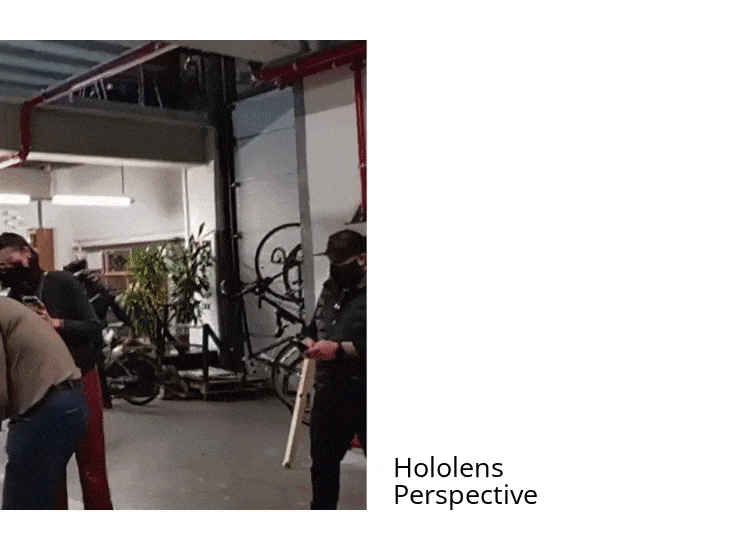
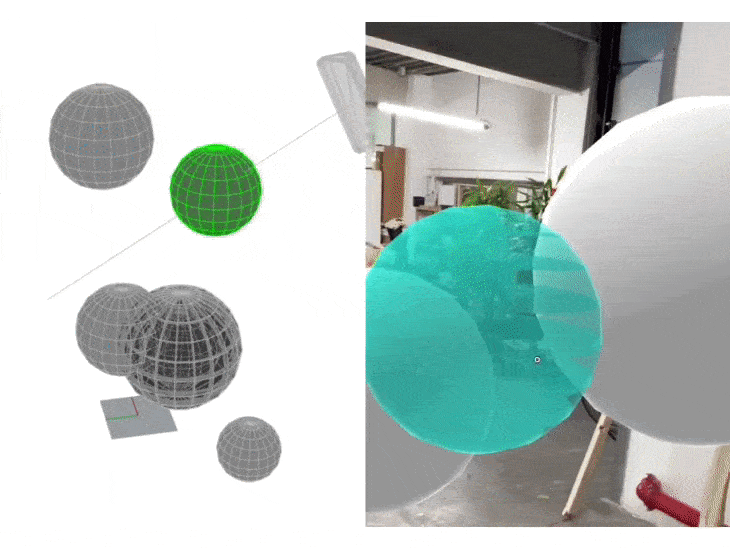
The ‘Vert Hex’ project begins with a challenge to address the outdoor environment. The team conceived a complimentary and overlapping base environment of parametric hexagons, and within that context developed the three ‘events’ of a single user-experience that could proceed in order through the three events, which are:
- Through the Doorway
- Choose your Scale
- Select and Edit
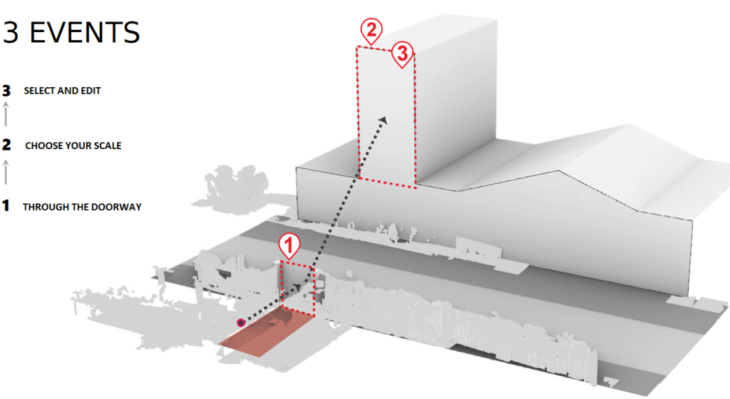
The ‘Through the Doorway’ event uses a virtual doorway consisting of a vertical array of hexagons in the same place that a real doorway is situated. The virtual doorway is set up in Rhino and Grasshopper and uses an attractor (a grasshopper component that can trigger changes based on proximity) to make most of the doorway disappear when the Hololens wearer approaches close enough.

‘Through the Door’ replaces large loading bay doors with a translucent array of hexagons
The effect is both magical and disconcerting – magical because of the way the hexagons disappear – shrinking to their centrepoints to reveal the real world behind them, as if they could float individually in space although together they make a kind of wall – and disconcerting because of how the Hololens wearer has to get so near to trigger the effect. Compared with a real door where you control passing through by a tried and trusted technique, such as using a handle or being clear the door is already open, this apparently closed and solid doorway with no handle requires a ‘leap of faith’ to try to walk into it. At the last moment being confident enough to try to walk into it makes most of it disappear and allows the real world beyond it to become visible.
The translucent hexagons disappear when the Hololens wearer gets close enough
Once the Hololens wearer has passed through the doorway, and the outside world is visible, on the façade of the tallest building opposite the ‘Choose your Scale’ event can be experienced. ‘Choose your Scale’ consists of two main elements: a hexagonal grid superimposed on a façade at a particular ‘scale’ to begin with, and a user-interface element that allows the ‘scale’ of the hexagons to be modified with a virtual slider. After using the virtual slider to modify the ‘scale’ of the hexagonal grid in view, the grid jumps to update.
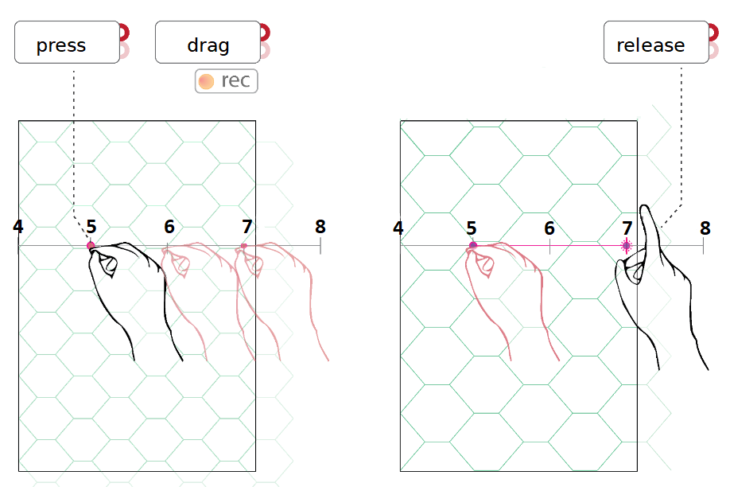
The idea of ‘scale’ was simplified to mean ‘how many hexagons are fitted across the width of the façade’. The number of hexagons in the height is then automatically adjusted also to keep the hexagonal cells regular in shape. The minimum number allowed was set to 4. With 4 hexagonal cells across the width of the façade programmed as the minimum, and set also as the default for starting to use the ‘Choose your Scale’ event, we then set a maximum of 8 in this case, because the façade was relatively narrow.
Scaling the grid on the facade of opposite buildings
The ‘Select and Edit’ event was developed more generically than the previous two: it covers vertical and horizontal uses of the overall ideas. ‘Select and Edit’ shows how gestures can be programmed to control how the hexagonal cells can be manipulated to change them from 2D planar cells to 3D volumes.
‘Select and Edit’ has three stages: first, directly on an hexagonal grid being viewed, the Hololens user chooses which cells to modify. A pair of gestures – pointing a ray from the index finger followed by pressing together the thumb and index finger to confirm the selection – allows the selection of a group of individual cells, which change colour to show they’ve been selected. This process of selection is then completed by another gesture. If a cell had been selected accidentally, there is also a ‘reset’ gesture to start again – clapping – shown in the image below.
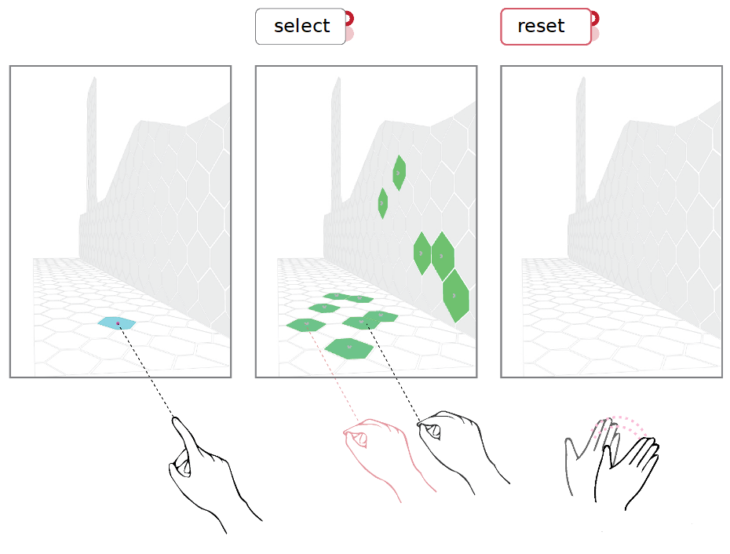
The extrusion came with another set of hand gestures. The selected hexagons could be extruded – with a hand gesture in ‘L’ followed by a rotation where the angle rotated was tracked by the Hololens – and then made conical by a penultimate gesture. A fully open hand would freeze the modified cells at that extruded conical state, and a clap would reset the canvas.

Testing ‘Select-Edit’ outside
Vert Hex is a project of IAAC, Institute for Advanced Architecture of Catalonia developed as part of the Master in Robotics and Advanced Construction in 2021/2022 by:
Students: Amy Kim, ?pek Attaro?lu and Christopher Booth
IAAC faculty: Daniil Koshelyuk
Visiting faculty (from Georgia Tech School of Architecture / Spatial Futures Lab): Keith Kaseman and Will Reynolds